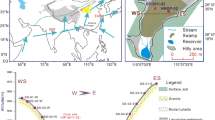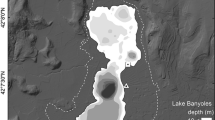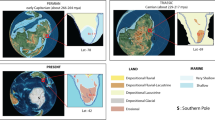Abstract
Climate change in the northeastern United States has been inferred for the last deglaciation to middle Holocene (∼16,600 to 6000 calendar years ago) using multi-proxy data (total organic matter, total carbonate content, δ18 O calcite and δ13 C calcite) from a 5 m long sediment core from Seneca Lake, New York. Much of the regional postglacial warming occurred during the well-known Bolling and Allerod warm periods (∼14.5 to 13.0 ka), but climate amelioration in the northeastern United States preceded that in Greenland by ∼2000 years. An Oldest Dryas climate event (∼15.1 to 14.7 ka) is recognized in Seneca Lake as is a brief Older Dryas (∼14.1 ka) cold event. This latter cold event correlates with the regional expansion of glacial Lake Iroquois and global meltwater pulse IA. An increase in winter precipitation and a shorter growing season likely characterized the northeastern United States at this time. The Intra-Allerod Cold Period (∼13.2 ka) is also evident supporting an “Amphi-Atlantic Oscillation” at this time. The well-known Younger Dryas cold interval occurred in the northeastern United States between 12.9 and 11.6 ka, consistent with ice core data from Greenland. In the Seneca Lake record, however, the Younger Dryas appears as an asymmetric event characterized by an abrupt, high-amplitude beginning followed by a more gradual recovery. Compared to European records, the Younger Dryas in the northeastern United States was a relatively low-amplitude event. The largest amplitude and longest duration anomaly in the Seneca Lake record occurs after the Younger Dryas, between ∼11.6 and 10.3 ka. This “post-Younger Dryas climate interval” represents the last deglacial climate event prior to the start of the Holocene in the northeastern United States, but has not been recognized in Greenland or Europe. The early to middle Holocene in the northeastern United States was characterized by low-amplitude climate variability. A general warming trend during the Holocene Hypsithermal peaked at ∼9 ka coincident with maximum summer insolation controlled by orbital parameters. Millennial- to century-scale variability is also evident in the Holocene Seneca Lake record, including the well-known 8.2 ka cold event (as well as events at ∼7.1 and 6.6 ka). Hemispherical cooling during the Holocene Neoglacial in the northeastern United States began ∼5.5 ka in response to decreasing summer insolation.
Similar content being viewed by others
References
Alley R.B., Mayewski P.A., Sowers T., Stuiver M., Taylor K.C. and Clark P.U. 1997. Holocene climatic instability: a prominent, widespread event 8200 yr ago. Geology 25: 483–486.
Alley R.B., Anandakrishnan S. and Jung P. 2001. Stochastic resonance in the North Atlantic. Paleoceanography 16: 190–198.
Anderson T.W. and Lewis C.F.M. 1985. Postglacial Water-level History of the Lake Ontario Basin. Geological Association of Canada, Special Paper No. 30, pp. 231–253.
Anderson W.T., Mullins H.T. and Ito E. 1997. Stable isotope record from Seneca Lake, New York: evidence for a cold paleoclimate following the Younger Dryas. Geology 25: 135–138.
Barber D.C., Dyke A., Hillaire-Marcel C., Jennings A.E., Andrews J.T., Kerwin M.W., Bilodeau G., McNeely R., Southon J., Morehead M.D. and Gagnon J.M. 1999. Forcing of the cold event of 8200 years ago by catastrophic drainage of Laurentide lakes. Nature 400: 344–348.
Bjorck S., Kromer B., Johnsen S., Bennike O., Hammarlund D., Lemdahl G., Possnert G., Rasmussen T.L., Wohlfarth B., Hammer C.U. and Spurk M. 1996. Synchronized terrestrial-atmospheric deglacial records around the North Atlantic. Science 274: 1155–1160.
Bjorck S., Muscheler R., Kromer B., Andresen C.S., Heinemeier J., Johnsen S.J., Conley D., Koc N., Spurk M. and Veski S. 2001. High-resolution analyses of an early Holocene climate event may imply decreased solar forcing as an important climate trigger. Geology 29: 1107–1110.
Bloomfield J.A. (ed.), 1978. Lakes of New York State: Volume 1-Ecology of the Finger Lakes. Academic Press, New York, 499 pp.
Bond G., Kromer B., Beer J., Muscheler R., Evans M.N., Showers W., Hoffmann S., Lotti-Bond R., Hajdas I. and Bonani G. 2001. Persistent solar influence on North Atlantic climate during the Holocene. Science 294: 2130–2136.
Broecker W.S., Kennett J.P., Flower B.P., Teller J.T., Trumbore S., Bonani G. and Wolfli W. 1989. Routing of meltwater from the Laurentide ice sheet during the Younger Dryas cold episode. Nature 341: 318–321.
Burnett A.W. and Mullins H.T. 2002. Atmospheric Circulation and the Oxygen Isotopic Composition of Meteoric Precipitation Over the Northeastern United States. American Geophysical Union Abstract with Program, San Francisco, CA.
Callinan C.W. 2001. Water Quality Study of the Finger Lakes. New York State Deptartment of Environmental Conservation, Albany, NY, (http://www.dec.state.ny.us/website/dow/fingerlakes/index.html).
COHMAP 1988. Climatic changes of the last 18,000 years: observations and model simulations. Science 241: 1943–1052 ■ ■ Author please check page range ■ ■.
Dansgaard W., Johnsen S.J., Clausen H.B., Dahl-Jensen D., Gundestrup N.S., Hammer C.U., Hvidberg C.S., Steffensen J.P., Sveinbjornsdottir A.E., Jouzel J. and Bond G. 1993. Evidence for general instability of past climate from a 250-kyr ice core record. Nature 364: 218–220.
Dean W. 1974. Determination of carbonate and organic matter in calcareous sediments and sedimentary rocks by loss on ignition: comparison with other methods. J. Sed. Petrol. 44: 242–248.
Dean W. 1999. The carbon cycle and biogeochemical dynamics in lake sediments. J. Paleolimnol. 21: 375–393.
Dean W. and Gorham E. 1998. Magnitude and significance of carbon burial in lakes, reservoirs, and peatlands. Geology 26: 535–538.
Drever J.I. 1997. The Geochemistry of Natural Waters, Surface and Groundwater Environments, 3rd edn. Prentice Hall, New York, 437 pp.
Dwyer T.R., Mullins H.T. and Good S.C. 1996. Paleoclimatic implications of Holocene lake-level fluctuations, Owasco Lake, New York, Geology 24: 519–522.
Effler S.W. and Johnson D.L. 1987. Calcium carbonate precipitation and turbidity measurements in Otisco Lake, New York. Water Res. Bull. 23: 73–79.
Effler S.W., Perkins M.G., Greer H. and Johnson D.L. 1987. Effect of “whiting” on optical properties and turbidity in Owasco Lake, New York. Water Res. Bull. 232: 189–196.
Effler S.W., Johnson D.L. and Callinan C.W. 2001. Selected features of Cayuga Lake from recent measurements. In: Wagenet L.P., Eckhardt D.A.V., Hairston N.G., Karig D.E. and Yager R. (eds), A Symposium on Environmental Research in the Cayuga Lake Watershed, Natural Resource, Agriculture and Engineering Service, Ithaca, NY, pp. 145–153.
Eichenlaub V.L. 1979. Weather and Climate of the Great Lakes Region. University of Notre Dame Press, South Bend, IN, 335 pp.
Fairbanks R.G., Charles C.D. and Wright J.D. 1992. Origin of global meltwater pulses. In: Taylor R.E. (ed.), Radiocarbon After Four Decades, Springer-Verlag, NY, pp. 473–500.
Folk R.L. 1974. Petrology of Sedimentary Rocks. Hemphill Publishing Co., Austin, TX, 182 pp.
Gat J.R., Bowser C.J. and Kendall C. 1994. The contribution of evaporation from the Great Lakes to the continental atmosphere: estimate based on stable isotope data. Geophys. Res. Lett. 21: 557–560.
Halfman J.D. and Herrick D.T. 1998. Mass movement and reworking of late glacial and postglacial sediments in northern Seneca Lake. Northeast. Geol. Environ. Sci. 20: 227–241.
Halfman J.D., Baldwin S.M., Rumpf J.P. and Giancarlo M.B. 2001. The impact of the zebra mussel (Dreissena polymorpha) on the limnology, geochemistry and sedimentology of Seneca Lake. In: Wagenet L.P., Eckhardt D.A.V., Hairston N.G., Karig D.E. and Yager R. (eds), A Symposium on Environmental Research in the Cayuga Lake Watershed, Natural Resource, Agriculture and Engineering Service, Ithaca, NY, pp. 154–166.
Hilfinger M.F. IV, Mullins H.T., Burnett A. and Kirby M.E. 2001. A 2500 year sediment record from Fayetteville Green Lake, New York: evidence for anthropogenic impacts and historic isotope shift. J. Paleolimnol. 26: 293–305.
Hodell D.A., Schelske C.L., Fahnenstill G.L. and Robbins L.L. 1998. Biologically induced calcite and its isotopic composition in Lake Ontario. Limnol. Oceanogr. 43: 187–194.
Hollander D.J. and Smith M.A. 2001. Microbially-mediated carbon cycling as a control on the δ 13C of sedimentary carbon in euthropic Lake Mendota (USA): new models for interpreting isotopic excursions in the sedimentary record. Geochim. Cosmochim. Acta 65: 4321–4337.
IPCC, 2001. Summary for Policy Makers (http://www.ipcc.ch).
Kelts K. and Talbot M.E. 1990. Lacustrine carbonates as geochemical archives of environmental change and biotic/abiotic interactions. In: Tilzer M.M. and Serruya C. (eds), Large Lakes: Ecological Structure and Function, Springer-Verlag, NY, pp. 288–315.
King J.W., Banerjee S.K., Marvin J. and Lund S. 1983. Use of small scale-amplitude paleomagnetic fluctuations for correlation and dating of continental climatic changes. Paleogeog. Paleoclim. Paleoecol. 42: 167–183.
Kirby M.E., Mullins H.T., Patterson W.P. and Burnett A.W. 2001. Lacustrine isotopic evidence for multidecadal natural climate variability related to the circumpolar vortex over the northeast United States during the past millennium. Geology 29: 807–810.
Kirby M.E., Patterson W.P., Mullins H.T. and Burnett A.W. 2002a. Post-Younger Dryas climate interval linked to circumpolar vortex variability: isotopic evidence from Fayetteville Green Lake, New York. Clim Dyn. 19: 321–330.
Kirby M.E., Mullins H.T., Patterson W.P. and Burnett A.W. 2002b. NE USA late glacial/Holocene paleo-atmospheric circulation and precipitation inferred from modern calibrated stable oxygen and carbon isotopes. Geol. Soc. Amer. Bull. 114: 1326–1340.
Lajewski C.K., Mullins H.T., Patterson W.P. and Callinan C.W. 2003. Historic calcite record from the Finger Lakes: impact of acid rain on a buffered terrain. Geol. Soc. Amer. Bull. 115: 373–384.
Levesque A.J., Mayle F.E., Walker I.R. and Cwynar L.C. 1993a. A previously unrecognized lateglacial cold event in eastern North America. Nature 361: 623–626.
Levesque A.J., Mayle F.E., Walker I.R. and Cwynar L.C. 1993b. The amphi-Atlantic oscillation: a proposed late-glacial climate event. Quat. Sci. Rev. 12: 629–643.
Manabe S. and Stouffer R.J. 1999. The role of thermohaline circulation in climate. Tellus 51A–B(1): 91–109.
McKenzie J.A. 1985. Carbon isotopes and productivity in the lacustrine and marine environments. In: Stumm W. (ed.), Chemical Processes in Lakes, Wiley, NY, pp. 99–118.
Meyers P.A. 2002. Evidence of mid-Holocene climate instability from variations in carbon burial in Seneca Lake, New York. J. Paleolimnol. 28: 237–244.
Michel R.L. and Kraemer T.F. 1995. Use of isotopic data to estimate water residence times of the Finger Lakes. J. Hydrol. 164: 1–18.
Muller E.H. and Calkin P.E. 1993. Timing of Pleistocene glacial events in New York State. Can. J. Earth Sci. 30: 1829–1845.
Muller E.H. and Prest V.K. 1985. Glacial lakes in the Ontario basin. Geol. Assoc. Can. Spec. Pap. 30: 213–229.
Mullins H.T. 1998a. Environmental change controls lacustrine carbonate, Cayuga Lake, New York. Geology 26: 443–446.
Mullins H.T. 1998b. Holocene lake level and climate change inferred from marl stratigraphy of the Cayuga Lake basin, New York. J. Sed. Res. 68: 569–578.
Mullins H.T. and Hinchey E.J. 1989. Erosion and infill of New York Finger Lakes: implications for Laurentide ice sheet deglaciation. Geology 17: 622–625.
Mullins H.T., Hinchey E.J., Wellner R.J., Stephens D.B., Anderson W.T., Dwyer T.R. and Hine A.C. 1996. Seismic stratigraphy of the Finger Lakes: a continental record of Heinrich event H-1 and Laurentide ice sheet instability. Geol. Soc. Amer. Spec. Pap. 311: 1–35.
Nesje A. and Kvamme M. 1991. Holocene glacier and climate variations in western Norway: evidence for early Holocene glacier demise and multiple Neoglacial events. Geology 19: 610–612.
Pair D.L. and Rodriquez C.G. 1993. Late Quaternary deglaciation of the southwestern St. Lawrence lowland, New York and Ontario. Geol. Soc. Amer. Bull. 105: 1151–1164 ■ ■ Author please check changes made in author name ■ ■
Patterson W.P. and Mullins H.T. 2002. A New Model for the Interpretation of Carbon Isotope Records of Lacustrine Calcite: Influence of Seasonal Precipitation and Humidity. Geological Society for American Abstract with Program 34, Denver, CO ■ ■ Author please check changes made, and if possible provide complete details ■ ■
Peteet D.M. 1992. The palynological expression and timing of the Younger Dryas event — Europe versus eastern North America. In: Bard E. and Broecker W.S. (eds), The Last Deglaciation: Absolute and Radiocarbon Chronologies, Springer-Verlag, NY, pp. 327–344.
Peteet D.M., Daniels R.A., Heusser L.E., Vogel J.S., Southon J.R. and Nelson D.E. 1993. Lateglacial pollen, macrofossils and fish remains in northeastern U.S.A. — the Younger Dryas oscillation. Quat. Sci. Rev. 12: 597–612.
Rozanski K., Araguas-Araguas L. and Gonfiantini R. 1993. Isotopic patterns in modern global precipitation. Amer. Geophys. Union Monogr. 78: 1–36.
Seltzer G.O., Rodbell D.T., Baker P.A., Fritz S.C., Tapia P.M., Rowe J.D. and Dunbar R.B. 2002. Early warming of tropical South America at the last glacial-interglacial transition. Science 296: 1685–1686.
Shemesh A. and Peteet D. 1998. Oxygen isotopes in fresh water biogenic opal-northeastern US Allerod-Younger Dryas temperature shift. Geophys. Res. Lett. 25: 1935–1938.
Stuiver M. and Reimer P.J. 1993. Extended 14C age calibration program. Radiocarbon 35: 215–130 ■ ■ Author please check page range ■ ■
Stuiver M., Grootes P.M. and Braziunas T.F. 1995. The GISP2 δ 18O climate record of the past 16,500 years and the role of the sun, ocean and volcanoes. Quat. Res. 44: 341–354.
Taylor K.C., Lamorey G.W., Doyle G.A., Alley R.B., Grootes P.M., Mayewski P.A., White J.W.C. and Barlow L.K. 1993. The “flickering switch” of late Pleistocene climate change. Nature 361: 432–436.
Taylor K.C., Mayewski P.A., Alley R.B., Brook E.J., Gow A.J., Grootes P.M., Meese D.A., Saltzman E.S., Severinghaus P., Twickler M.S., White J.W.C., Whitlow S. and Zielinski G.A. 1997. The Holocene-Younger Dryas transition recorded at Summit, Greenland. Science 278: 825–827.
Thompson J.B., Schultze-Lam S., Beveridge T.J. and DesMaraia D.J. 1997. Whiting events: biogenic origin due to the photosynthetic activity of cyanobacterial picoplankton. Limnol. Oceanogr. 42: 133–141.
von Grafenstein U., Erlenkeuser H., Muller J., Jouzel J. and Johnsen S. 1998. The cold event 8200 years ago documented in oxygen isotope records of precipitation in Europe and Greenland. Clim. Dyn. 14: 73–81.
von Grafenstein U., Erlenkeuser H., Braer A., Jouzel J. and Johnsen S.J. 1999. A mid-European decadal isotope-climate record from 15,500 to 5000 years B.P. Science 284: 1654–1657.
Wellner R.J. and Dwyer T.R. 1996. Late Pleistocene-Holocene lake-level fluctuations and paleo-climates at Canandaigua Lake, New York. Geol. Soc. Amer. Spec. Pap. 311: 65–76.
Wing M.R., Preston A., Acquisto N. and Ahrnsbrak W.F. 1995. Intrusion of saline groundwater into Seneca and Cayuga Lakes, New York. Limnol. Oceanogr. 40: 791–801.
Woodrow D.L., Blackburn T.R. and Monahan E.C. 1969. Geological, chemical and physical attributes of sediments in Seneca Lake, New York. Proc. Conf. Great Lakes Res. 12: 380–396.
Author information
Authors and Affiliations
Corresponding author
Rights and permissions
About this article
Cite this article
Ellis, K.G., Mullins, H.T. & Patterson, W.P. Deglacial to middle Holocene (16,600 to 6000 calendar years BP) climate change in the northeastern United States inferred from multi-proxy stable isotope data, Seneca Lake, New York. J Paleolimnol 31, 343–361 (2004). https://doi.org/10.1023/B:JOPL.0000021853.03476.95
Issue Date:
DOI: https://doi.org/10.1023/B:JOPL.0000021853.03476.95




